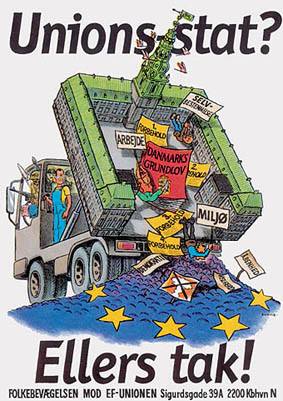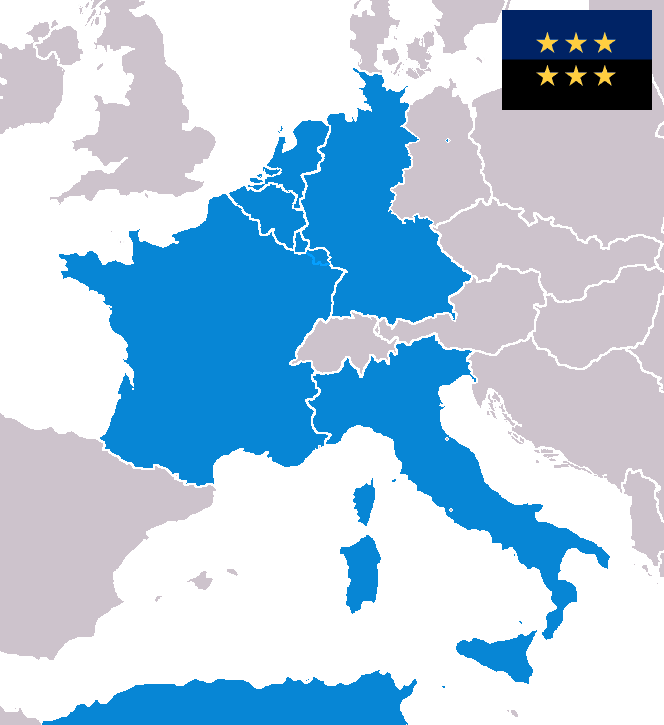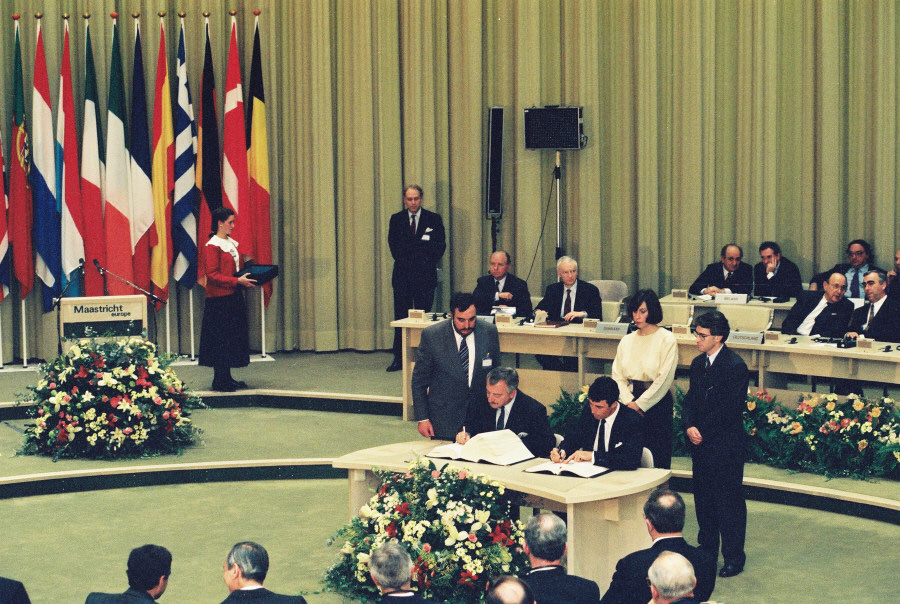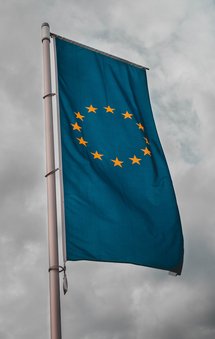An overview of Denmark and its integration with Europe, 1940s to the Maastricht Treaty in 1993
Denmark has been a cautious participant of European supranational integration since the Second World War, evaluating the pros and cons of integration, and making the decision to ‘opt in’ when there were benefits. The driving force behind Denmark's accession to the EEC was the desire to become part of an open European economy, rather than support for federalism. Key parliamentary decisions on European integration were made by consensus between the main political parties, regardless of the coalition in power.

Post-war
The prerequisites of contemporary European integration can be traced back to the end of the Second World War. Already in 1947-1948 the Danish government was eager to participate in the Marshall Plan and its institutional expression in the form of the Organization for European Economic Cooperation, which allowed Denmark to restore its economy by the early 1960s. Danish participation was confined to the economic sphere without involvement in political and security issues. Denmark was also positive about Churchill’s project to create the Council of Europe, becoming in 1949 one of its founding countries. However, Danish representatives opposed any transfer of national authority on security matters to the Council.
Aligning foreign policy with emerging European communities
The creation of the European Coal and Steel Community (ECSC) (Paris Treaty of 1951), the European Atomic Energy Community (EAEC or Euratom) and the European Economic Community (EEC) (the Treaty on the Functioning of the European Union (TFEU); also referred to as the Treaty of Rome, 1957), necessitated the Danish government to align its foreign policy with the activities of the emerging European communities.

PICTURE: Map showing the founding countries of the European Coal and Steel Community in 1951. Their flag in the top right corner bears resemblance to the current flag of the European Union. Picture: JLogan. Wikimedia Commons, Public Domain.
The preparation of Denmark's entry into the Common Market was initiated in 1957 by the Liberal Party (Venstre), representing the interests of farmers who were attracted by the benefits of the common agricultural policy. Danish exports to Germany experienced growth, while exports to the UK were limited due to its protectionist measures. In the late 1950s the country faced a dilemma: cooperation in the economic sphere with Germany - the founder of the ECSC, EAEC and EEC, - or with the UK, who remained outside of European integration.
The Danish government followed the decision of the UK to apply for joining the EEC first in 1961, then again in 1967. From the first attempt, EEC enlargement did not take place because of the opposition of the French President Charles de Gaulle to UK participation. De Gaulle, however, was positive about the prospect of Danish membership. The Prime Minister of Denmark Jens Otto Krag expressed his solidarity with the UK, although Danish exports to Western Germany were growing, while exports to the UK were limited by continuing protectionist measures, and the Danish farmers were growing more and more in favour of joining the EEC regardless of the route the UK would choose.
Domestic political situation in 1960s leading to referendum in 1972
A resolution had to therefore be found in the domestic political processes. As a matter of fact, the majority of Danish political parties supported Danish membership of European economic integration. The Liberals (Danmarks Liberale Parti Venstre) and Conservatives (Det Konservative Parti) were staunch supporters of joining the EEC; even more federalist sentiments were observed in a small party - the Centre Democrats (Centrum-Demokraterne). In Denmark, euroscepticism historically prevailed on the political left, represented by the Socialist People's Party (Socialistisk Folkeparti), which at that time did not enjoy great political influence. The Social Democratic Party (Socialdemokratiet) traditionally found itself between the Eurosceptical left and the right, highlighting the Nordic integration projects as an alternative.
The participation of Denmark in the EEC was the result of a complex negotiation process and a meticulous evaluation of the alternatives. It was the result of a consensus reached between the main political parties – Liberal, Conservative and Social Democratic – eventually approved by their supporters. At the Hague Summit in 1969, six of the founding member countries of the EEC reviewed the applications. Denmark's entry into the community was then approved at a national referendum in 1972 with 63.3% of the votes against 36.7%, and Denmark entered the community together with the UK and Ireland in 1973.
Denmark as a go-between the Nordics and the EEC
As the only Nordic member state of the EEC, Denmark soon assumed the role of mediator between the Nordic countries and the EEC. Domestic political conditions throughout the 1970s and 1980s forced the Danish government to pursue a rather restrained policy with regard to deepening integration, especially in the institutional sphere. In particular, Denmark reacted negatively to the introduction of direct elections to the European Parliament. At the first elections to the European Parliament in 1979, four out of 15 deputies from Denmark represented the national movement ’Against the EU’. In the subsequent elections to the European Parliament, movements against the EU also received rather strong support. In 1986, despite the backing from the government, the Danish parliament (Folketing) voted against the Single European Act because of its federalist content.
The political crisis between the government and parliament was resolved through a national referendum on February 27, 1986, in which 56.2% of the voting population supported the Single European Act. However, in a number of cases, especially when the economic interests were at stake, Denmark played a constructive role in supporting European integration projects, in particular, the creation of the European Monetary System (EMU) in 1979.
PICTURE: EU has been and still is a widely debated topic in Danish politics. Photo: Sara Kurfeß, Unsplash.
Maastricht voted down despite an increase in support for Europe integration in 1990s
By the early 1990s internal political conditions in Denmark had changed in relation to the EEC. On the one hand, these changes were associated with the increasing coordination between the main political forces related to Denmark's participation in European integration. The Socialist People's Party ceased to advocate for Denmark's withdrawal from the EEC. The Social Democratic and Social Liberal parties, which had dominated the government since 1993, also became staunch supporters of European integration, although there were still some differences amongst the membership of both parties. On the other hand, the reorientation of left-wing and centrist political parties was facilitated by the international situation associated with the collapse of the USSR and the Warsaw Pact, which reduced the need for balancing interests between the blocs. In parallel with the reorientation of political parties, there was an increase in support for Denmark's participation in the EEC, which by the beginning of the 1990s reached 60–70% of the population. The main task became to strengthen the political authority of Denmark within the framework of this organization.
The majority in Folketing supported Denmark’s all-embracing participation in the EU: on 12th May 1992, only 25 MPs voted against the ratification of the Maastricht Treaty, while 130 members voted in its favour. However, despite the general trend of positive sentiment towards the EU, 50.7% of Danes voted ’against’ the ratification of the Maastricht Treaty in a referendum on 2nd June 1992. The so-called ’June Movement’ against the EU was created.

Foreign minister Uffe Ellemann-Jensen and Anders Fogh Rasmussen signing the Treaty of Maastrict on behalf of Denmark. Photo: Christian Lambiott. European Communities, Audiovisual Service.
Reservations from the Maastricht Treaty
Danes voting against the ratification of the Maastricht Treaty in 1992 was an unexpected result for Uffe Ellemann-Jensen, the Danish Foreign Minister at the time, who was one of the most active and staunch supporters of European integration. Ellemann-Jensen had been certain that the Danes "would not just say yes, but yes, please” to the EU. Therefore, the Danish politicians, including Ellemann-Jensen, found themselves in a rather difficult situation regarding the decision on further cooperation between Denmark and the EU. The result of intense negotiations between seven of the eight parliamentary parties, including the anti-Maastricht Socialist People’s Party, was a ’national compromise’, which safeguarded Denmark’s right to select individual sections of the treaty to comply with. As a result, Denmark acceded to the Maastricht Treaty with four reservations securing its refusal to:
-
introduce a single European currency in Denmark;
-
participate in the formation of a single foreign and security policy;
-
introduce a common European citizenship; and
-
introduce cooperation at the supranational level in the fields of justice and internal affairs.
Denmark's cooperation in these areas would require initial approval by popular referendum. At the EU Summit in Edinburgh in December 1992, 11 EU member states supported Denmark. As a result, at a subsequent referendum on 18th May 1993, 56.8% of Danes approved the signing of the agreement. The stage was set for the next stage of European integration for Denmark, albeit with reservations.
Further reading:
-
Hjalte Rasmussen, Folkestyre, Grundlov og Højesteret : grundlovens § 20 på prøve [Democracy, Constitution and Supreme Court: § 20 on trial] (København: Christian Ejlers, 1996).
-
Lizaveta Dubinka, 'Evolution of the Danish Foreign Policy towards the EU', Brest State University Journal, 3 (2008), pp. 113-120.
-
Lizaveta Dubinka-Hushcha, Foreign Policy of Denmark (1972-2012), PhD dissertation, (Minsk: Belarusian State University, 2014).
-
Nikolaj Petersen, 'Europæisk og globalt engagement 1973-2006' [European and Global engagement 1973-2006], Dansk Udenrigspolitiks Historie [History of Danish Foreign-Policy], vol. 6. (København: Gyldendals Leksikon, 2006).
